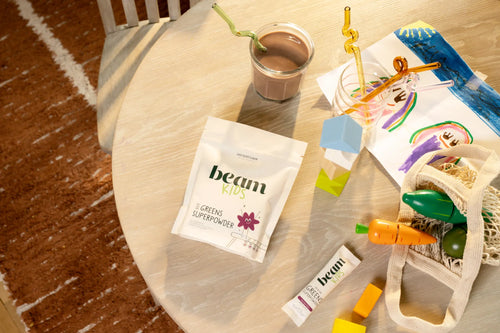Protein for Kids Made Simple for Parents
Making sure your child gets enough protein is important, but it doesn’t have to be stressful. Depending on their age and activity level, kids usually need between 10 and 34 grams of protein each day to support healthy growth and development.
Many parents worry about finding the best protein for kids, coming up with fun protein ideas for kids, or wondering, “Is protein powder safe for kids?” The good news is that with a few simple swaps and some creativity, it’s easy to include plenty of nutrient-dense foods in your child’s diet. These foods provide the essential amino acids and vitamins they need to stay active, healthy, and strong.
Getting kids involved in the kitchen is another great way to make healthy eating enjoyable. When mealtime feels fun, they’re more likely to try protein-rich foods and see them as part of a balanced, healthy diet that keeps their energy up and supports steady growth every day.
Why Protein Matters in a Child’s Diet
Protein is one of the key nutrients behind your child’s growth, energy, and immune system. It’s the building block that helps create and repair cells, muscles, and tissues. Without enough protein, kids may feel tired, recover more slowly, or experience slower growth.
Building Blocks for Growth and Development
Think of protein as your child’s personal construction team. Every part of their body, from muscles to hair, needs protein to grow properly. Since kids go through regular growth spurts, getting enough protein becomes even more important. A steady intake of healthy protein helps keep their energy levels stable and supports overall development.
Essential Amino Acids and the Immune System
Your child’s immune system also depends on protein to stay strong. The essential amino acids found in protein help create antibodies that fight infections and support recovery after illness. Because the body can’t make these amino acids on its own, they need to come from food. Regular protein intake from a variety of sources helps keep kids healthy and resilient.
How Much Protein Kids Really Need
One of the most common questions parents ask is how much protein kids actually need. Most children meet their protein needs naturally through balanced meals and snacks. Here’s a quick look at daily recommendations:
- Ages 1–3: about 13 g per day
- Ages 4–8: about 19 g per day
- Ages 9–13: about 34 g per day
- Teens: Girls about 46 g, Boys about 52 g
These numbers follow the Recommended Dietary Allowances (RDAs) for children. Active kids or young athletes may need slightly more, around 1.2 to 1.5 g of protein per kilogram of body weight, but this is typically only for those with intense physical activity or during rapid growth periods.
Protein per Meal and Snack
Instead of serving all the protein in one big meal, spread it throughout the day:
- Younger kids: 5–10 g per meal
- Older children: 10–15 g per meal
Examples:
- Breakfast: scrambled eggs with whole wheat toast (10–12 g)
- Lunch: turkey wrap (15 g)
- Snack: Greek yogurt or apple slices with nut butter (5–8 g)
- Dinner: grilled chicken or fish (20 g)
This balanced distribution keeps kids full, energized, and satisfied from morning to bedtime.
Best Sources of Protein for Children
When it comes to the best protein for kids, whole foods are your best friend. They offer not only protein but also vitamins, minerals, fiber, and healthy fats that help kids stay full and energized. Here are some of the top options:
Animal-Based Proteins
- Lean meats, poultry, and fish: Chicken, turkey, and grilled salmon or tuna are classic choices packed with nutrients.
- Eggs: Hard-boiled eggs, omelets, or egg muffins make easy, portable options.
- Dairy and low-fat dairy products: Milk, Greek yogurt, and cottage cheese are rich in protein and calcium.
- Lean cuts of beef or pork: Trimmed, lean cuts can be a healthy part of your child’s diet.
These foods are complete proteins, meaning they contain all nine essential amino acids your child’s body needs.
Plant-Based Protein Sources Kids Enjoy
For vegetarian or mostly plant-based families, there are plenty of delicious, good sources of protein for kids:
- Beans and lentils: Black beans, chickpeas, and kidney beans (about 15 g per cup cooked)
- Soy foods: Tofu, tempeh, and edamame are complete plant proteins
- Nut and seed butters: Peanut butter, almond butter, and sunflower seed butter
- Nuts and seeds: Chia seeds, hemp seeds, and pumpkin seeds
- Whole grains: Quinoa, buckwheat, and whole wheat bread
- Fortified plant milks: Soy or pea milk for dairy-free options
Pairing legumes and grains, like beans and rice, can help create a complete protein profile for kids who don’t eat animal products.
Is Protein Powder Safe for Kids?
It’s normal to wonder if protein powder is safe for kids, especially if your child is a picky eater or has a busy schedule. In most cases, kids get plenty of protein from regular meals. Still, some parents consider supplements when their child needs a little extra nutritional support.
Why Whole Foods Comes First
Whole foods naturally provide the right mix of protein, fiber, healthy fats, and nutrients that growing bodies need. Meals that include lean meat, eggs, dairy, or beans usually supply enough protein without requiring any extra supplements.
Adult protein powders, however, are designed for fitness goals and may contain more protein or additives than kids need. If you want to add a powder to your child’s routine, choose one made specifically for children and review the ingredients carefully.
When Supplements Might Help
There are a few times when a protein supplement may be helpful:
- During recovery from illness or surgery
- When appetite is low or selective
- For highly active kids or young athletes who burn more energy
- Even then, experts suggest using child-formulated options in moderation and under a doctor’s or dietitian’s advice.
A Balanced Approach
Protein powders can be an easy way to mix up snack time, but they’re not a must. Try blending a smoothie with milk, fruit, and a scoop of greens for kids to boost vitamins, minerals, and plant nutrients. It’s a great way to add variety while keeping meals wholesome and balanced.
Protein Ideas for Kids (Kid-Friendly Meals and Snacks)
Here are some fun and easy ways to add more protein for kids into their day:
- Greek yogurt parfait with berries and granola
- Peanut butter and banana toast on whole wheat bread
- Egg muffins baked with veggies
- Chicken or turkey strips with steamed vegetables
- Bean or lentil soup with whole-grain bread
- Smoothie made with milk, spinach, nut butter, and banana
- Cottage cheese with fruit
- Hummus with veggie sticks or pita
- Tofu cubes or edamame as snacks
- Cheese sticks or small lean-beef sliders
- Quinoa bowls with beans and colorful vegetables
Let kids join in the fun food activities by assembling wraps, smoothies, or snack bowls. It helps them get excited about protein-rich foods and builds healthier eating habits over time.
Smart Nutrition Choices for Growing Kids
Getting enough protein for kids doesn’t have to mean complicated meal plans or pricey supplements. Focus on offering a mix of whole, nutrient-dense foods throughout the day, from morning eggs to evening beans. Most children naturally meet their protein needs through balanced, tasty meals.
Remember, it’s about quality over quantity. For picky eaters, try adding a chocolate or vanilla smoothie blended with milk and a scoop of Beam Kids Greens Superpowder for extra nutrients. It’s a simple way to boost vitamins and minerals while keeping things kid-friendly and delicious.
Trust your child’s appetite, keep their meals colorful and balanced, and reach out to a healthcare professional if you have specific concerns about meeting their protein requirements.
Frequently Asked Questions (FAQ):
How much protein does my child need daily?
The recommended daily protein intake for children varies by age. Toddlers need about 13 grams daily, while school-age children require 19-34 grams depending on their age and activity level. During puberty, kids may need slightly more protein due to rapid growth and development. Most children easily meet their protein needs through a balanced diet without requiring supplementation.
What are the best protein sources for picky eaters?
For children who are selective eaters, try incorporating protein through foods they already enjoy. Nut butters (like peanut or almond butter) with apple slices, yogurt tubes, and whole wheat pasta are excellent options. Other kid-friendly choices include hummus with vegetables, oatmeal with added seeds, cheese sticks, and smoothies with added plant-based protein powders designed specifically for children's nutritional needs.
Can kids get enough protein from plant-based sources?
Yes, children can absolutely meet their protein requirements through plant-based foods. Excellent plant protein sources include beans, lentils, quinoa, nuts, seeds, and whole grains. These foods not only provide protein but also offer additional nutrients like fiber, vitamins, and minerals that support overall growth and development. Combining different plant proteins throughout the day ensures a complete amino acid profile.
Is too much protein harmful for children?
While protein is essential for growth, excessive protein intake, particularly from supplements, can strain the kidneys and lead to unwanted weight gain. Most children get adequate protein from regular meals and snacks without the need for extra supplementation. Focus on whole-food sources rather than protein powders unless specifically recommended by a healthcare provider for your child's individual needs.



